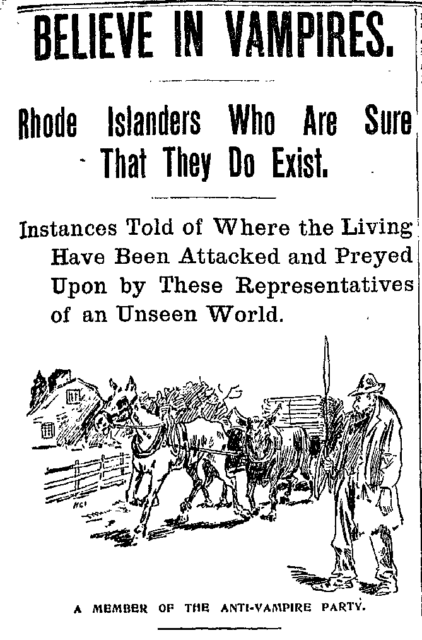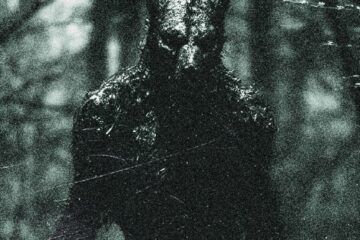Vampires are an often occurring boogyman in Western culture. Still, few have a true grasp of the knowledge surrounding these notorious creatures of the night, especially in modern times, where most compare vampires to cool, sexy anti-heroes with an eye for fashion. However, vampires are far from anything we’d consider pleasant, and history has a plethora of lore surrounding vampires that reveal the genuinely grotesque evil nature of these monstrous parasites.
However, these tales are usually associated with Eastern Europe, Egypt, and the ancient Mesopotamian world. But, in 1892, Rhode Island was the vampire capital of America, in a tale that found worldwide renown. News outlets across the states printed out countless stories on the topic. With the rise of tuberculosis deaths of the era, everyone was looking for a mental escape from the depressing reality of the contagion. The demons of the Old World were knocking, and a shiver of paranormal fear spread across the U.S. like a virus.
In the village of Exeter, Rhode Island, a man named George Brown was the unluckiest man in the community. His wife had died unexpectedly from an unexplained and unfamiliar illness that caused chaos in his New England home life. His twenty-year-old daughter, Mary Olive Brown, also became afflicted by strange contagion and perished only six months after his wife’s death. But this tragedy was just the beginning. In the coming years, his other daughter, Mercy Brown, would also tragically pass on unexpectedly. Edwin Brown, George’s teenage son, seemed to out of nowhere become frail and ill. George Brown definitely seemed like the unluckiest man in Rhode Island. Yet, his troubles were only beginning.
[the_ad_placement id=”manuel”]
Doctors told George that his family kept dying because of “consumption,” which was a common form of death in those days. But then again, this was a time of superstition, and all these tragedies were painting George in a cursed light. This paranoia caused the village men to come to a very different conclusion than the doctors: a vampire had been sucking the life of George’s family. The only way to save Edwin from dying, too, was to find the vampire and end its evil for good. Madness befell the small New England town, with the talk of vampirism spreading like wildfire.
On a cold and windy day in 1892, a group of men from the village entered the village graveyard to dig up the bodies of George Brown’s deceased relatives. They concluded that since the vampire was only oppressing the man’s family, it was most likely a former family member. If the bodies were decomposing correctly, then they’d search for the vampire elsewhere. No matter what, the men were determined to find a body buried in the graveyard that did not show signs of decay.

You’d be surprised how much worldwide lore originates from Mesopotamia.
This idea (whether known or unknown to the villagers) goes back to the very origin of Western vampire lore. In the ancient Mesopotamian civilization, a king’s duty was to protect their people from predators, monsters, other societies, and the spirit world. Their duty was to fight off supernatural forces and protect the spiritual aspects of the subjects in the kingdom they ruled. And this service did not end with death. So their bodies were preserved and well-kept to remain undecomposed as long as possible, and rituals were performed to empower their etheric form. Once the body fully decayed, so too did the energy body of the king. This idea is the core of original vampire lore. Vampires are spiritual entities, not physical. At least in the original concept of what we’d call the Western vampire. Folklore is constantly evolving and changing, and one interpretation is not superior to any other, so the biological vampire is just as relevant and similar to other vampiric legends of the East.
But, back to the vampire hunt.
The men dug up each grave one by one as the wind howled around them, chilling them all to the bone. One by one, they discovered the bodies to be appropriately decomposing in the frozen earth. Yet when they came upon Mercy’s grave and opened the coffin, the men were consumed in fear. Her body was free of corruption, and fresh blood trickled from the supposedly dead flesh when prodding it with their shovels. The fresh blood that she’d drank from others. Her hair had grown, as well as her fingernails, and her position in the coffin was not the traditional way corpses were laid to rest, which the men claimed was proof she’d been moving about in undeath. To the villagers, they’d found their vampire.
They removed the heart from the corpse, which to them seemed perfectly healthy as if the girl never died. They burned the heart to ashes on a rock nearby, then collected it to take back to the sick Edwin and add it to his medicine. They did not destroy the body, though, or even stake it to the ground as was the custom of the Old World. People think that stake-ing the heart is the classical way to kill a vampire, but this is a misunderstanding. The stake is meant to go through the body and into the ground, which has esoteric effects upon the vampire that makes it unable to travel etherically, or depending on the culture, even physically. Edwin died not long after despite the villager’s efforts. However, nobody from the Brown family was affected after the corpse was exhumed and the heart burned, and the ritualized act of vampire slaying seemed to ease the tensions of the villagers and help them cope.

Vampire hysteria was nothing new to New Englanders.
The accounts of this vampirism diverge in different ways depending on who’s telling the story. People claimed to have seen the vampire wandering the graveyard and in neighboring fields searching for a life force to feed upon in self-nourishment. Some said the entity visited them in the darkness of their rooms in the dead of night to just stare at them. Others claimed Mercy haunted them in night terrors and horrific dreams that re-occurred at certain times of the year. The legend of the vampire would only grow, and many claimed Mercy Brown would not stay dead, roaming the streets of Rhode Island and taking many lives. And in the new dawn of an age of science, this vampire legend would refuse to die out.
Mercy’s grave exists to this day and can be visited by anyone at Chestnut Hill Cemetary, White Baptist church in Rhode Island. The grave, a famous piece of history and folklore, is reinforced and embedded into the ground to avoid inappropriate interaction. And people claim to see her spirit even in modern times, roaming the graveyard searching for new blood. In any case, Mercy Brown is remembered as the Last Vampire of New England and one of the most well-documented vampire hunts in history.

She was the last American vampire.
Lame Normie Explanation:
In modern times we know that fingernails and hair appear to keep growing on corpses because of natural deterioration. Depending on which version of the tale you subscribe to, Mercy had been stored upon death because the ground was too frozen to dig her a grave, and the cold could have easily preserved her body. Not to mention that it was freezing when she was eventually buried, which also would have preserved her body. Bacteria in decomposing bodies can make movement occur from gases and the like, making her preserved body seem animate to a degree. Terbuculosis was a common contagion of the time, and her family was killed from it, just like many in those days. BUT IGNORE ALL THIS, and just go back to thinking it was a real vampire!

Be thankful we don’t have to live with tuberculosis. It had an 80% fatality rate.





0 Comments